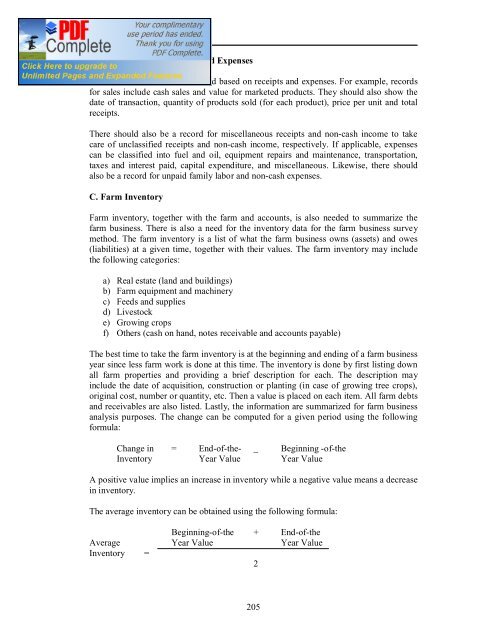(IPPM) in Vegetables - Vegetableipmasia.org
(IPPM) in Vegetables - Vegetableipmasia.org
(IPPM) in Vegetables - Vegetableipmasia.org
Create successful ePaper yourself
Turn your PDF publications into a flip-book with our unique Google optimized e-Paper software.
Resource Manual on <strong>IPPM</strong> <strong>in</strong> Vegetable<br />
World Education Philipp<strong>in</strong>es, Inc.<br />
B. Classification of Receipts and Expenses<br />
Farm records have to be classified based on receipts and expenses. For example, records<br />
for sales <strong>in</strong>clude cash sales and value for marketed products. They should also show the<br />
date of transaction, quantity of products sold (for each product), price per unit and total<br />
receipts.<br />
There should also be a record for miscellaneous receipts and non-cash <strong>in</strong>come to take<br />
care of unclassified receipts and non-cash <strong>in</strong>come, respectively. If applicable, expenses<br />
can be classified <strong>in</strong>to fuel and oil, equipment repairs and ma<strong>in</strong>tenance, transportation,<br />
taxes and <strong>in</strong>terest paid, capital expenditure, and miscellaneous. Likewise, there should<br />
also be a record for unpaid family labor and non-cash expenses.<br />
C. Farm Inventory<br />
Farm <strong>in</strong>ventory, together with the farm and accounts, is also needed to summarize the<br />
farm bus<strong>in</strong>ess. There is also a need for the <strong>in</strong>ventory data for the farm bus<strong>in</strong>ess survey<br />
method. The farm <strong>in</strong>ventory is a list of what the farm bus<strong>in</strong>ess owns (assets) and owes<br />
(liabilities) at a given time, together with their values. The farm <strong>in</strong>ventory may <strong>in</strong>clude<br />
the follow<strong>in</strong>g categories:<br />
a) Real estate (land and build<strong>in</strong>gs)<br />
b) Farm equipment and mach<strong>in</strong>ery<br />
c) Feeds and supplies<br />
d) Livestock<br />
e) Grow<strong>in</strong>g crops<br />
f) Others (cash on hand, notes receivable and accounts payable)<br />
The best time to take the farm <strong>in</strong>ventory is at the beg<strong>in</strong>n<strong>in</strong>g and end<strong>in</strong>g of a farm bus<strong>in</strong>ess<br />
year s<strong>in</strong>ce less farm work is done at this time. The <strong>in</strong>ventory is done by first list<strong>in</strong>g down<br />
all farm properties and provid<strong>in</strong>g a brief description for each. The description may<br />
<strong>in</strong>clude the date of acquisition, construction or plant<strong>in</strong>g (<strong>in</strong> case of grow<strong>in</strong>g tree crops),<br />
orig<strong>in</strong>al cost, number or quantity, etc. Then a value is placed on each item. All farm debts<br />
and receivables are also listed. Lastly, the <strong>in</strong>formation are summarized for farm bus<strong>in</strong>ess<br />
analysis purposes. The change can be computed for a given period us<strong>in</strong>g the follow<strong>in</strong>g<br />
formula:<br />
Change <strong>in</strong> = End-of-the- _ Beg<strong>in</strong>n<strong>in</strong>g -of-the<br />
Inventory Year Value Year Value<br />
A positive value implies an <strong>in</strong>crease <strong>in</strong> <strong>in</strong>ventory while a negative value means a decrease<br />
<strong>in</strong> <strong>in</strong>ventory.<br />
The average <strong>in</strong>ventory can be obta<strong>in</strong>ed us<strong>in</strong>g the follow<strong>in</strong>g formula:<br />
Beg<strong>in</strong>n<strong>in</strong>g-of-the + End-of-the<br />
Average Year Value Year Value<br />
Inventory =<br />
2<br />
205




![Section 4 [ PDF file, 252 KB] - The Field Alliance](https://img.yumpu.com/51387260/1/158x260/section-4-pdf-file-252-kb-the-field-alliance.jpg?quality=85)












